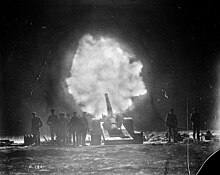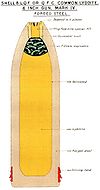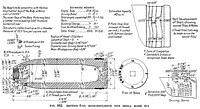BL 6 inch Mk VII naval gun
| BL 6 inch Mk VII naval gun | |
|---|---|
| General Information | |
| Military designation: | BL 6 inch Mk VII naval gun |
| Manufacturer designation: | BL 6 inch Mk VII naval gun |
| Manufacturer country: |
|
| Developer / Manufacturer: | Vickers |
| Development year: | 1899 |
| Production time: | 1899 to 1916 |
| Number of pieces: | 898 |
| Model variants: | MK VII, MK VIII, MK XXIV |
| Weapon Category: | Ship gun, field cannon, coastal artillery gun |
| Technical specifications | |
| Pipe length: | 6.81 m (22 ft 4 in) |
| Caliber : |
152.4 mm (6 in) |
| Caliber length : | 45 |
| Weight ready for use: | Gun including breech: 7.654 kg
With Scott carriage: 20,000 kg |
| Cadence : | 8 rounds / min |
| Elevation range: | 22 degrees of angle |
| Furnishing | |
| Closure Type : | Welin screw lock system |
| Charging principle: | Breech loader |
| Ammunition supply: | Single loader |
| Range: | 12,500 m to 14,400 m (depending on the ammunition used) |
The BL 6 inch Mk VII naval gun (just like the identically constructed Mark VIII) was a cannon originally developed in 1899 as a naval gun , which was also used as a heavy field gun for the Royal Garrison Artillery during the First World War . This cannon was used as a ship gun until World War II and was used in coastal artillery until the 1950s.
Development history
The BL 6 inch Mk VII naval gun was developed to replace the QF 6 inch / 40 naval gun from 1890. While the older QF 6-inch / 40 cannon used cartridged ammunition with brass casings, the successor model reverted to the grenade with a separate silk pouch propellant, as Vickers had found that the new Welin screw cap had a just as fast rate of fire could be achieved as with cartridged ammunition. Vickers also promised a significant saving in storage space on board warships . Two variants of this gun were built:
- the Mark VII guns, the breech of which was opened to the right and
- the Mark VIII cannons, the breech of which was opened to the left,
In this way, optimal operation of the guns was achieved with double mounts. Guns in single mounts, on the other hand, were always of the Mark VII version.
Mission history
Ship gun


The weapon was first used on the Formidable- class battleships and then installed in numerous other ships of the Royal Navy . The use took place in ships of the:
- Centurion- class (battleships, renewal of central artillery in 1902)
- Duncan- class (battleships)
- Formidable class (battleships)
- Iron Duke class (battleships)
- King Edward VII class (battleships, only installed at Commonwealth , Dominion , Hindustan , King Edward VII , New Zealand )
- Tiger (battle cruiser)
- Cressy- class (armored cruiser)
- Devonshire class (armored cruiser)
- Drake- class (armored cruiser)
- Monmouth- class (armored cruiser)
- Challenger- class (protected cruisers)
- Humber- class ( monitors )
- M15 class (monitors)
- Insect class ( gunboats )
During the Second World War, the gun was still used on auxiliary cruisers such as Rawalpindi and Jervis Bay or passenger ships such as Laconia .
Field cannon
The first of these guns arrived on the Western Front in 1915. In order to be able to use them as field cannons, they were equipped with an improvised so-called Scott mount , named after its inventor, Admiral Sir Percy Scott .


These guns were preferably used for fighting down enemy artillery positions and for fighting targets in the depths of the area. The guns were operated by soldiers from the Royal Garrison Artillery, as was customary in the First World War on the British side. A battery consisted of four guns. Beginning in October 1916, the gun was replaced by the lighter and more modern BL 6 inch Gun Mk XIX due to its inadequate mount ; the remaining guns were used until the end of the war and immediately withdrawn by the British Army after the armistice .
Coastal artillery
→ See also: List of coastal guns
The BL 6 inch Mk VII naval gun together with the BL 9.2 inch gun Mk IX – X provided the main armament of the coastal artillery of the United Kingdom and the Commonwealth . Many of the guns from decommissioned old warships of the Royal Navy were overhauled after the end of the First World War and also supplied to the coastal artillery associations; these guns remained in this role until the coastal artillery was disbanded in the 1950s. A total of 103 pieces were still used by the coastal artillery. A few guns were provided with reinforced gun barrels in the interwar period, which made the use of stronger cordite charges possible, these guns were then renamed the BL 6 inch Mk XXIV naval gun .
ammunition
|
|
|
|
|
|
|
Existing copies
- Rotunda, Royal Artillery Museum, London
- Coastal artillery gun in Newhaven Fort, Sussex, UK
- Coastal artillery gun built in 1904 at New Tavern Fort , Gravesend, UK
- Two Mark VII guns on Fort Dunree, Lough Swilly, Ireland
- Field gun on Scott mount The Front Museum, Lappohja, Finland
- Fort Ogilvie, Point Pleasant Park , Halifax, Nova Scotia
- Gun Numbers: 1489 and 1317 at Fort Nepean , Victoria
- Mk VII gun dated 1902 Mark VII gun, built in 1902, Ile aux Aigrettes, Mauritius
- Fort Siloso, Sentosa Island , Singapore
- [1] Momi, Vuda, Batteries, Viti Levu, Fiji Islands. Gun number: 1266, built in 1900
Web links
- Per Finsted, Om den engelske 6-tommers feltkanon 1914–1940 (in Danish) , accessed on March 6, 2012
literature
- Dale Clarke: British Artillery 1914-1919. Heavy artillery. Osprey Publishing, Oxford UK 2005 , ISBN 9781841767888 .
- Tony DiGiulian: British 6 "/ 45 (15.2 cm) BL Mark VII 6" / 45 (15.2 cm) BL Mark VIII 6 "/ 45 (15.2 cm) BL Mark XXIV .
- General Sir Martin Farndale: History of the Royal Regiment of Artillery. Western Front 1914-18. Royal Artillery Institution, London 1986, ISBN 978-1870114004 .
- General Sir Martin Farndale: History of the Royal Regiment of Artillery. The Forgotten Fronts and the Home Base, 1914-18. Royal Artillery Institution, London 1988, ISBN 9781870114059 .
- IV Hogg, LF Thurston: British Artillery Weapons & Ammunition 1914–1918. Ian Allan, London 1972, ISBN 9780711003811 .
- Admiral Percy Scott: Fifty Years in the Royal Navy. Published 1919.
- Siegfried Breyer: Battleships and battle cruisers 1905–1970. JF Lehmanns, Munich 1970, ISBN 3-88199-474-2 .
- Michael JH Taylor: Jane's Fighting Ships of World War I. Studio, 1990, ISBN 1-85170-378-0 .
- RA Burt: British Battleships 1889-1904. Naval Institute Press, Annapolis, Maryland 1988, ISBN 0870210610 .
- Roger Chesneau, Eugene M. Kolesnik (Eds.): Conway's All The World's Fighting Ships 1860-1905. Mayflower Books Inc., New York 1979, ISBN 0831703024 .
- Tony Gibbons: The Complete Encyclopedia of Battleships and Battlecruisers: A Technical Directory of All the World's Capital Ships From 1860 to the Present Day. Salamander Books Ltd., London 1983.
- Randal Gray (Ed.): Conway's All The World's Fighting Ships 1906-1921. Naval Institute Press, 1985, ISBN 0870219073 .
- Richard Ellis, Ben Warlow: The Royal Navy at Malta. Volume One - The Victorian Era 1865-1906. Maritime Books, Liskeard 1989, ISBN 0-907771-43-2 .
- Robert Gardiner (Ed.), John Roberts (Ed.): Great Britain. In: Conway's all the Worlds Fighting Ships 1860-1905. Conway, London 1979, ISBN 0-85177-133-5 .
- Fred T. Jane: Jane's Fighting Ships 1914. Sampson, Low & Marston, London 1914.
- HM Le Fleming: Cruisers (British and German). In: Warships of World War 1. Ian Allan, London (in single deliveries).
- Douglas Morris: Cruisers of the Royal and Commonwealth Navies. Maritime Books, Liskeard 1987, ISBN 0-907771-35-1 .
- Kizu Tohru: History of British Cruisers. Kaijinsha, Tokyo 1996. (Ships of the World Vol. 517)








